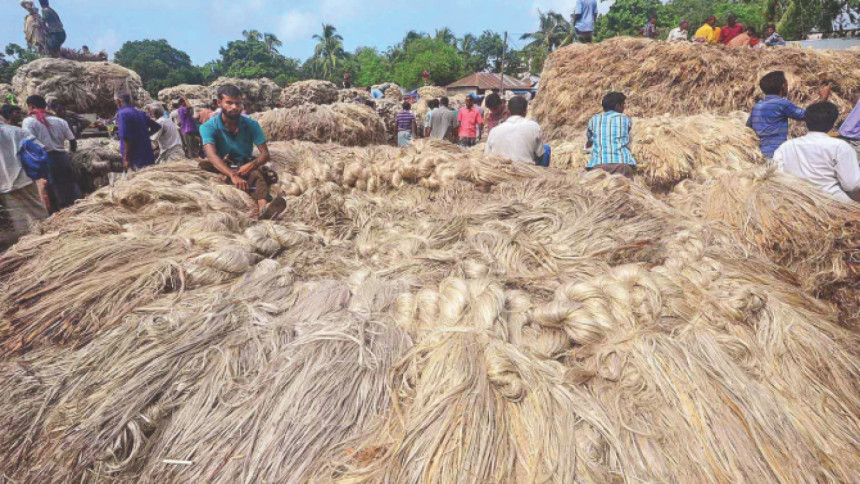The irony of it all

We have witnessed progress despite obstacles in the jute industry since my last op-ed (October 15, 2014, The Daily Star), where I had emphasised on the lack of a long-term development strategy, limited research and development, and a complacent execution of the mandatory packaging act.
The Bangladesh government under the leadership of Prime Minister Hasina has undertaken a long term strategy to completely overhaul the public sector (BJMC) jute mills. The state-owned mills have been making losses for several years in a row, with last year's loss amounting to Tk. 588 crore. With the help of Chinese funding, 24 public sector mills will be modernised, which is expected to generate about USD 119 million in profits and create 24,000 new jobs.
Furthermore, the government has decided to take up a project worth Tk. 2,800 crore for balancing, modernising, rehabilitating and expanding the mills. Investment from China will be about Tk. 2,240 crore. Upon completion of the project, the revenue of the public sector mills will increase to Tk. 3,743 crore up from Tk. 1,041 crore currently. The mills will be able to manufacture high value items, such as car dashboards, curtains and linen cloth amongst others, from raw jute. The Chinese company will buy back some of these goods produced by the mills after the completion of the project.
However, the traditional export markets of jute yarn continue to be weak and depressed due to the on-going conflict in the Middle East.
We have indeed started our journey towards the golden future that awaits, but there are obstacles along the way. The biggest obstacle in recent times has come in the form of the anti-dumping duty imposed by the government of India on the imports of jute products from Bangladesh.
The government of India has imposed an anti dumping duty of USD 6.30 to USD 351.72 per tonne on imports of jute products from Bangladesh and Nepal, following a recommendation by the Directorate General of Anti-Dumping and Allied Duties. This anti-dumping duty increases the cost of jute products imported from Bangladesh. Our products are no longer able to compete with jute products manufactured in India due to higher prices as a result of the anti-dumping duty. The irony is that some of the raw jute used in making the jute products in India come from Bangladesh. Anti-dumping duty has not been imposed on raw jute. We export about 0.38 million tonnes of raw jute every year, the majority of which goes to India. Finished goods export to India are about 0.17 million tons.
Exports to India currently account for 20 percent of Bangladesh's total jute export revenue. Jute mills that are heavily reliant on exports to India may have to close down, rendering thousands jobless. Millers are no longer being able to make any profit on shipments to India. Numerous exporters are facing problems at the border, where their shipments are undergoing additional scrutiny for LCs opened prior to the imposition of the duty.
The Indian Jute Mills Association (IJMA) initiated this process by submitting a petition on behalf of 15 member mills to the Directorate General of Anti-Dumping and Allied Duties (DGADAD). These companies comprised 36 percent of the market share. This did not constitute a significant market share; hence a few other petitioner companies were added to the list by IJMA to comprise a significant market share as required by the DGADAD to commission such a project. However, neither party explains as to why these companies were added later on, besides meeting the technical requirement of representing a certain percentage of the market share. There are 91 jute mills in India, of which 34 are members of IJMA, yet only a few were handpicked to file the petition. None of the non-member mills were part of the petition. The data presented by IJMA to DGADAD is highly skewed and biased.
This petition was filed in part due to the 19 jute mills shutting down as of June 11, 2015. There is no direct causality or empirical evidence that suggests that these companies shut down as result of imports from Bangladesh and Nepal. Birla Corporation, Gloster Jute Mills and Ludlow Jute and Specialties mention in their annual reports that the production of raw jute declined, thereby leading to higher raw jute prices.
Furthermore, there has been increased usage of synthetic bags and sudden and sharp increase in wages due to lack of manpower, as per the audit reports of Birla Corporation, Cheviot Company Ltd and Ludlow Jute & Specialties Ltd.
While manufacturers in India faced increases in labour and raw material costs, mills in Bangladesh enjoyed cost advantages. They enjoy a government subsidy on exports in addition to lower labour costs. Bangladesh produces the most superior quality of raw jute in the world, with countries like India and China importing raw jute from here.
DGADAD analysed the imports to India from Bangladesh and Nepal for a period of nine months. Instead, the imports should be analysed for a period of 5-10 years. The research report is highly flawed due to improper sample selection and highly skewed data. The Indian government purchases 70 percent of the domestic production and the manufacturers are still unable to meet the total government demand.
The total consumption of jute and jute products in India is about 1.5 million metric tonnes, whereas imports from Bangladesh is about 0.17 million metric tonnes. Imports from Bangladesh constitute about 11 percent of the total Indian consumption, which is not a significant amount to cause damage to the domestic industry. Increases in cost of production in India have been higher than increases in revenue per tonne; this has led to a gradual decline in capacity utilisation.
As a result of the anti-dumping duty, Bangladeshi exporters are no longer able to make profits on shipments to India. While the Indian government has imposed anti-dumping duty on jute products, no duty has been imposed on raw jute imports from Bangladesh. India is essentially allowing duty-free imports of raw jute to prevent loss of jobs in the Indian jute industry at the expense of loss of jobs in the Bangladeshi jute sector.
The export of raw jute to India is affecting the Bangladeshi jute industry in more ways than one. While these exports are helping to keep India's jute mills alive, they have resulted in a higher raw jute price in Bangladesh. Raw jute price in Bangladesh soared north of Tk. 2,400 per mound in 2016, up from Tk. 1,700-1,800 per mound a year ago. Due to increase in the cost of raw materials, our jute mills are struggling to supply to an already depressed export market.
In order to stabilise the prices of raw jute, the government of Bangladesh had temporarily banned the export of raw jute in late 2015. However, at the request and insistence of the Indian government, Bangladesh lifted the ban. The beneficiaries of the raw jute exports to India include only a few people – primarily jute traders who are the middlemen and the Indian jute industry.
As our priorities lie with protecting the jobs in the Bangladeshi jute sector, we must immediately ban raw jute exports to India while the anti-dumping duty is in place. Exporting finished jute goods and goods higher up in the value chain are more beneficial to Bangladesh than just exporting raw jute, as they will increase revenue and jobs. The desired result can also be achieved in the form of an export tax on raw jute as well. Only jute exporters, who are middlemen, will be affected by such an action. The benefits to the jute industry clearly outweigh the needs of the few middlemen.
A stabilised raw jute market is not just good for jute goods exports from Bangladesh in the short run, but also in the long run. Manufacturers would be motivated to innovate and undertake more research and development for new products. Such an ecosystem will foster growth and lead to higher export revenues and creation of more jobs in the jute sector. The government has ambitious plans for the jute sector, but without quality raw jute none of the products manufactured will be worthy of exports.
The writer is Deputy Managing Director at Nawab Abdul Malek Jute Mills.


 For all latest news, follow The Daily Star's Google News channel.
For all latest news, follow The Daily Star's Google News channel. 



Comments